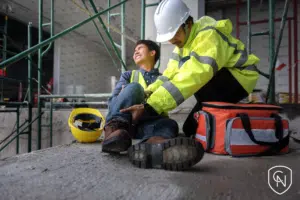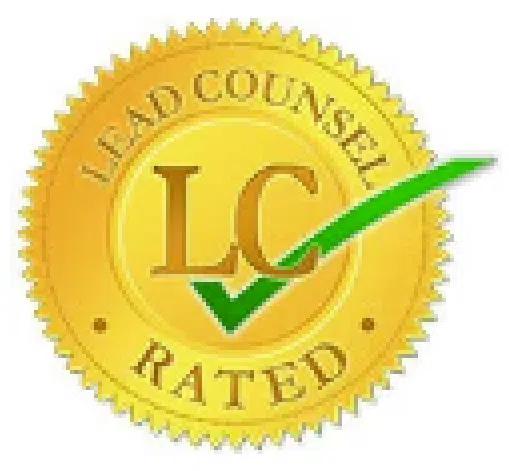New York City Construction Accident Lawyer

Home » New York Construction Accident Lawyer
Legally Reviewed by:
Alex Nocerino

READ BIO
Alex Nocerino is a founding partner at our firm and a successful trial lawyer with roots in New York. He is a member of the New York State Bar Association, the New York State Trial Lawyers Association, and the American Association for Justice. He has helped injured individuals win hundreds of millions in compensation from large corporations, government entities, and wealthy landlords.
With 18 years of experience, he has been recognized as a Super Lawyer since 2019 and has a five-star Avvo rating. He is a true New Yorker and a successful trial lawyer who is unafraid to go up against even the powerful and combative defendants.
Content Last Updated: June 25, 2025
ON THIS PAGE
- Why Choose Chopra and Nocerino, LLP, to Handle Your New York Construction Accident Case?
- Workers’ Rights After a Construction Accident
- New York Statute of Limitations
- Compensation in a Construction Accident Case
- FAQs About Construction Accidents in New York
- Common Causes and Injuries in Construction Accidents in New York
- Understanding Construction Laws in New York
- Preventing Construction Accidents and Safety Measures
- When You’re Hurt, We Step Up to the Plate
Construction work is a constant reality in a city like New York, filling the streets with the sound of machinery, trucks, and construction crews. Unfortunately, construction sites are also some of the most hazardous workplaces out there. Hundreds of construction site accidents occur annually across the state, with 554 injuries and 11 fatalities in New York City in one recent year alone.
While workers’ compensation can help offset accident-related costs, but it might not be enough to fully pay for your injuries and losses. That is where the New York construction accident lawyers at Chopra & Nocerino, LLP, come in. Our knowledgeable legal team is well-versed in construction accident lawsuits.
We can help you negotiate an insurance settlement and take your case to court if the at-fault party and their insurers do not compensate you fairly. If you were injured on a construction site, do not wait to have your case reviewed by an experienced construction accident attorney in NYC. Schedule your free consultation today by filling out our online form.
Why Choose Chopra and Nocerino, LLP, to Handle Your New York City Construction Accident Case?
At Chopra & Nocerino, LLP, we are very proud of our work helping injury victims throughout New York defend their right to compensation. We understand that construction accidents often result in devastating, life-altering injuries. We are here to help you and your family in your hour of need.
Our knowledgeable personal injury lawyers in New York have years of experience handling personal injury cases and possess expertise in New York’s construction laws. We strive to provide personalized, compassionate representation to each of our clients as we work to maximize their compensation. We set ourselves apart from other law firms through our client-centric approach. When you choose us to handle your case, you can count on us to work tirelessly on your behalf.
Our award-winning attorneys have been recognized by numerous legal organizations and publications for the high quality of our services and dedication to our clients:
- Forbes Advisor: Featured Partner for top legal qualifications and client service
- Top 10 Under 40 by the National Academy of Personal Injury Lawyers
- 2021 & 2024 Attorney of the Year by Top 100 Lawyers
- National Trial Lawyers Top 100
- Designated Super Lawyers
We’re real New Yorkers with a strong track record of success. Our firm has secured hundreds of millions of dollars in verdicts and settlements for our clients. Some recent results we have achieved on behalf of injured construction workers include:
- $3.5 million after a construction worker, age 28, suffered a severe hand injury requiring surgery. Though he didn’t suffer injuries beyond his hand, that single injury prevented him from returning to work.
- $3 million after a construction worker, age 42, fell off a ladder and injured his spine. The resulting injury required spinal surgery. We reached a settlement in Brooklyn shortly before his case was set for trial.
Our client testimonials reflect our unyielding dedication to our clients and their cases. Read what they have to say:
- “The team at Chopra & Nocerino is amazing. They were polite, thorough, and helped my family through a very tough process. They understand the physical, financial, and emotional hardships that a sudden injury can bring, and they are very powerful advocates in court. I can think of no better firm to recommend to someone who has been in an accident.” – Armando T.
- “I can’t recommend Chopra & Nocerino enough. They took my case when no one else would and earned me a settlement that most didn’t think was possible. They have the resources of a larger firm but treat you as if you are their only client. Great firm with great lawyers, especially Alex Nocerino.” – Marty B.
- “Chopra & Nocerino, LLP, I give them a 5-star because they treat their clients with respect. They always have a positive attitude. The whole team brings a refreshing energy to any situation. Chopra & Nocerino, LLP, I will always give you an A+. You are focused, driven, and constantly getting the job done. They have worked very hard on my case, and I was more than pleased with the outcome. I highly recommend Chopra & Nocerino, LLP, to all my friends, family, everyone.” – Theresa K.
If you or a loved one were injured in a New York construction accident, we’re here to help. We are a full-service personal injury firm ready to handle your case from start to finish. Contact us today to schedule your free consultation.
Workers’ Rights After a Construction Accident
After an accident, employees can pursue workers’ compensation to help offset living and medical costs while they heal from their injuries. Employees in all for-profit and most non-profit businesses in New York are eligible for workers’ compensation, but there is no residency requirement.
Once you seek medical attention, file a report with your supervisor, and are ready to complete the New York workers’ compensation claims process, follow the steps below to file a claim. Before filing, however, it is wise to have one of our attorneys review your case in a free, no-obligation consultation.
- Gather information –You’ll need to gather all relevant information to file a claim, including the date of the accident, a description of your injuries, your employer’s name and address, and your pre-tax wages.
- Complete the C-3 form – Fill out everything you can with as much detail as possible in the C-3 employee claim form online.
- Call the Worker’s Compensation Board – If you prefer to speak to someone on the phone first, you can call (866) 396-8314 to speak with a representative who will take your information and help you complete the C-3 form.
- Wait for approval – The Workers’ Compensation Board will review your claim and then decide whether to approve or deny it. If approved, you’ll receive payments every two weeks during your disability period.
However, workers’ compensation isn’t always enough to cover steep medical bills and other expenses associated with a construction accident. In these cases, pursuing compensation from the at-fault party through a personal injury lawsuit might be a better option. It is best to figure this out before filing for workers’ compensation by having your case evaluated by an experienced construction accident lawyer in New York.
New York Statute of Limitations
In New York, the statute of limitations for most personal injury lawsuits is three years. This means you have three years from the date of your injury to file your claim.
Subject to very few exceptions, failure to comply with this strict rule normally results in your case being dismissed in court. Our experienced New York construction accident attorneys will make sure your case is filed before this all-important deadline.
Compensation in a NYC Construction Accident Case
A skilled construction accident attorney in NYC can help you seek compensation for things like medical expenses, lost wages, pain, and suffering.
Calculating “economic damages,” such as lost wages or medical bills, is fairly straightforward. Your lawyer can use the totals from documents like pay stubs and medical bills to determine how much you are owed.
However, calculating “non-economic damages,” such as pain and suffering, is trickier because they are much more subjective in nature. Therefore, you need an empathetic attorney on your side who understands the true impact your injuries have on your life.
A third type of compensation, known as punitive damages, may also be available in certain personal injury cases. This form of damages is reserved as punishment for defendants guilty of seriously reckless or otherwise reprehensible behavior.
For example, suppose a construction site owner repeatedly broke federal and state labor laws to get a project done faster, resulting in your injury. You could potentially be eligible for punitive damages if your lawyer proves that the at-fault party’s behavior rose to a certain level of irresponsibility. A skilled New York City construction accident lawyer at our firm can review your accident and determine whether punitive damages could be available.
FAQs About Construction Accidents in New York
Lawsuits are complicated, and clients normally come through our doors with lots of questions. We answer a few of the most common ones below. We hope this page has been informative and that you do not hesitate to reach out to have your remaining questions and concerns addressed in your free consultation.
1. What Legal Recourse Do Family Members Have if a Construction Accident Causes a Loved One’s Death in NYC?
If you lose a loved one in a construction accident, you may pursue compensation through a wrongful death lawsuit against the at-fault party. New York law allows personal representatives of decedents to seek damages for wrongful acts, neglect, or default that result in death.
2. Can Undocumented Workers Involved in Construction Accidents Sue in New York?
Yes. The 14th Amendment of the U.S. Constitution guarantees due process and equal protection for citizens and non-citizens alike. Your immigration status does not prohibit you from pursuing compensation for injuries sustained in a New York construction accident. Chopra & Nocerino, LLP, proudly serves all members of our community regardless of their immigration status.
3. What Should I Do If My Employer Retaliates Against Me for Filing a Workers’ Compensation Claim?
Several state and federal laws are designed to protect you against this kind of retaliation by your employer. Under these laws, your employer cannot retaliate against you for reporting a safety concern or filing a claim. If they do, you can file a complaint.
4. How Can a Lawyer Assist When Negotiating with Insurance Companies in NYC?
Unfortunately, insurance companies try to save money by settling claims quickly for as little money as possible. Even your own insurer cannot be trusted to protect your best interests.
By contrast, your attorney is legally obligated to put your best interests first and can defend your rights against unscrupulous insurers. Our NYC construction accident lawyers understand their tactics and can help make sure any settlement agreement you enter is fair. If a fair out-of-court agreement cannot be reached, we can take your case to court.
5. What Should I Do If My Workers’ Compensation Claim Is Denied?
You can appeal a workers’ compensation claim denial. However, contesting a decision to deny your claim can be legally complicated. Our construction accident lawyers in New York City can help you determine your full rights and options and figure out the best way to proceed.
Common Causes and Injuries in Construction Accidents in New York City

- Falls from heights
- Equipment failure and malfunction
- Crane accidents
- Scaffolding accidents
- Fires and explosions
- Building and scaffolding collapses
- Contact with toxic chemicals
- Inexperience operating heavy machinery, like forklifts
The kinds of accidents you can sustain are as numerous and diverse as their potential causes. Common injuries we see in the construction accident cases we handle include:
- Burns (thermal, chemical, and electrical)
- Cuts and puncture wounds
- Broken and fractured bones
- Eye injuries
- Head and neck injuries
- Crushing injuries
- Spinal cord injuries
- Traumatic brain injuries
- Chemical exposure illnesses
Understanding Construction Laws in New York
New York labor laws, as well as federal regulations set by the Occupational Safety and Health Administration (OSHA), protect workers by setting safety standards on construction sites.
For example, workers at most major construction sites in New York must have completed OSHA 10 training in the previous five years. Labor Law 200 details general duties to protect employee health and safety. Other general rules include a ban on smoking at construction sites, safety training requirements, and daily inspection requirements.
Certain laws only apply in specific scenarios, such as New York’s laws regarding work in high-rise buildings. Under Labor Law 240, construction workers on high-rises must be provided with safety equipment. Labor Law 241 outlines stringent rules for safety code violations during construction, excavation, and demolition work.
Under federal OSHA standards, employers must also initiate and maintain accident prevention programs to improve worker safety. Other OSHA rules outline standards for recording/reporting injuries, personal protective equipment, and the general health/safety of workers. When responsible parties fail to abide by these rules and regulations, they can be held liable for resulting accidents.
Because of the multi-layered nature of the construction industry, third parties might also take on liability for construction accidents. A skilled New York construction accident lawyer can help you identify the at-fault parties in your case and hold them responsible.
Preventing Construction Accidents and Safety Measures
Preventing construction accidents comes down to taking precautions, training workers, and staying aware. For example, using proper personal protection equipment (PPE) can help minimize the risk of accidents. Regular safety training can also help by familiarizing workers with appropriate protocols.
Further, reporting risks to employers can help them mitigate hazards they might be unaware of. That said, employers are primarily responsible for ensuring workplace safety through routine inspections, training programs, and complying with safety standards.
When You’re Hurt, We Step Up to the Plate
Construction sites are hectic places, and the accidents that occur on them can lead to devastating injuries. The skilled New York construction accident lawyers at Chopra & Nocerino, LLP, can help you hold the at-fault party accountable and pursue the compensation you deserve. Contact us today to schedule your free, no-obligation consultation.


CONTACT A LAWYER TODAY
ON THIS PAGE
- Why Choose Chopra and Nocerino, LLP, to Handle Your New York City Construction Accident Case?
- Workers’ Rights After a Construction Accident
- New York Statute of Limitations
- Compensation in a NYC Construction Accident Case
- FAQs About Construction Accidents in New York
- Common Causes and Injuries in Construction Accidents in New York City
- Understanding Construction Laws in New York
- Preventing Construction Accidents and Safety Measures
- When You’re Hurt, We Step Up to the Plate
- $3.5 MILLION
CONSTRUCTION ACCIDENT - $3 MILLION
CONSTRUCTION ACCIDENT - $550,000
CONSTRUCTION ACCIDENT
TESTIMONIALS
MEET THE ATTORNEYS


















